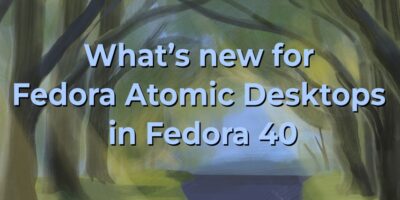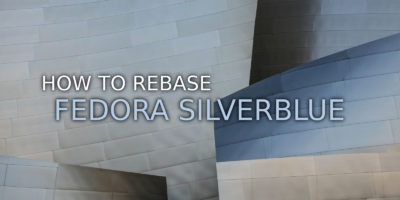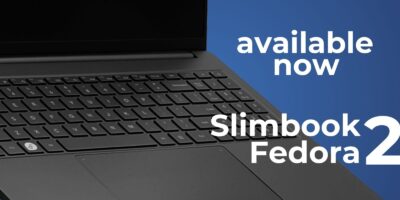Oh, wow. This feels like a big number! I’m proud to announce the 40th release of Fedora Linux, a community-built and community-maintained operating system that belongs to all of us. I’m also happy to note that we’re back on track with an on-time release. Thank you to all Fedora contributors who made that possible, and who have, yet again, made this our best one ever.
This is also a personally exciting number for me, because this marks the 20th release for which I’ve served as Fedora Project Leader. We’ve gone through a lot in this last decade, and I’m incredibly happy to see our community thrive and grow. In addition to many long-familiar names and faces, it’s exciting to see a new generation with new energy and ideas. In some cases, this is literally a new generation, as many of you have grown up with Fedora. But at whatever age, I’m proud we’ve built such a welcoming and friendly community, and that we continue to work at improving our inclusiveness, diversity, and accessibility.
But anyway! Enough of that. Time to see what we’ve got for you in Fedora Linux 40! If you have a system already, Upgrading Fedora to a New Release is easy. If you’re new, or just curious, head to Get Fedora for installation options.
Desktop news
Fedora Workstation Edition features the GNOME desktop environment, now updated to version 46. Check out What’s New in Fedora Workstation 40? for the highlights!
The KDE Spin now includes KDE Plasma 6, and runs with Wayland out of the box. Read more about that and other KDE Spin updates at What’s New in Fedora KDE 40?
We’re also officially reviving the “Fedora Atomic Desktop” brand for all of our variants which use ostree or image-based provisioning. Our technology isn’t really “immutable”, so this provides a better grouping. Read more about this at Introducing Fedora Atomic Desktops — but in short, Fedora Silverblue and Fedora Kinoite will remain, while the other desktop variants will become Fedora Sway Atomic and Fedora Budgie Atomic.
Tools for AI development
Fedora Linux 40 ships with our first-ever PyTorch package. PyTorch is a popular framework for deep learning, and it can be difficult to reliably install with the right versions of drivers and libraries and so on. The current package only supports running on the CPU, without GPU or NPU acceleration, but this is just the first step. Our aim is to produce a complete stack with PyTorch and other popular tools ready to use on a wide variety of hardware out-of-the-box.
We’re also shipping with ROCm 6 — open-source software that provides acceleration support for AMD graphics cards. We plan to have that enabled for PyTorch in a future release.
Updates all around!
As usual, we’ve rebuilt everything in the distribution using updated compilers and libraries (and, of course, those updated tools are ready for developers to use). These updates bring bugfixes, security improvements, and performance gains.
And, of course, hundreds of Fedora packagers and testers have worked to integrate the latest versions of open source software from thousands of upstream projects. Those projects, in turn, are made by an uncountable number of developers and contributors working on marketing, design, documentation, code, quality, translations, communications, events, governance, infrastructure, security, and so much more. Thank you again to everyone who makes Fedora amazing, and to everyone whose work has built this whole universe of free and open source software.
Speaking of updates…
There are several important release-day bugfix and security updates available today as well. If you upgrade from an earlier Fedora Linux release, you’ll get them as part of that. For new installations, please make sure to check for and apply updates as soon as possible.
In the unlikely event of a problem…
If you run into a problem, visit our Ask Fedora user support forum. This includes a category for common issues.
Or if you just want to say “hello”…
Drop by our “virtual watercooler” on Fedora Discussion and join a conversation, share something interesting, and introduce yourself.
Also, remember that our annual contributor conference, Flock To Fedora, is coming up! It’ll be in Rochester, New York this August. The call for session proposals is still open, if you have something you’d like to share or work on. If you’re already a Fedora contributor, or are interested in being one, or think you might be, we’d love to see you there!






Cory Hilliard
Great Job, everyone!
I’ll be updating my work laptop later today and my home computer tonight!
Then all the other people I’ve convinced to drop windows and use Linux full-time.
Stardenver
There is no thumbs up button in the comments section. Therefor: thumbs up, especially for your last paragraph.
Sudirman
Kudos on releasing Fedora 40!
Randy
But why is Wayland broken in Fedora 40 Gnome edition? Drag n Drop between programs like Skype, Google Chrome and nautilus is simply hit and miss with Wayland. X11 works just fine but I thought Wayland was the next big thing but how can it not work on a Fedora 40 release???? WHY ???? I hav AMD video card using the default driver but I nee to use X11 if I want to get work done which is very disappointing.
Richard England
Might be best to take your question to the Ask channel or the Matrix channel
sandalphonh
Maybe Skype and Chrome don’t support Wayland, when I use Firefox, it works
user
probably your google chrome is not using wayland. try going into chrome://flags and settings “Preferred Ozone platform” to “Auto” or “Wayland” directly and check if you still have problems.
AJCxZ0
Be warned that the current version of Chrome – 124.0.6367.78 – has broken using Wayland this (correct) way, resulting in transparent windows.
The workaround is to run using “google-chrome –enable-feature=UseOzonePlatform –ozone-platform=wayland”.
Andrew J. Caines
This has not been fixed in 124.0.6367.91.
Roman
All of these applications use Electron.
m
afaik skype is based on the qt framework
PE
Skype does indeed use Electron, and has for quite some time now.
joe lynch
What is Skype ; ) ?
kiaumo
The transparency of the Chrome window came up with Rawhide, and I think it’s Wayland’s problem
pranav
It would be great if the benchmark on proper use of internet speed on Fedora competes with Windows.
Pawel
If you want to find a worthy opponent for Windows, I would suggest MS DOS. Not sure if it connects to Internet, though.
Stan
You will need to be more specific — Ethernet or WiFi?
And Fedora packages two network speedtest tools:
$ dnf -Cq repoquery speedtest*
speedtest-0:1.3.0-1.fc39.noarch
speedtest-cli-0:2.1.3-9.fc39.noarch
Usage:
$ speedtest-cli
Retrieving speedtest.net configuration…
Testing from [removed]
Retrieving speedtest.net server list…
Selecting best server based on ping…
Hosted by [removed] [12.36 km]: 6.093 ms
Testing download speed…
Download: 97.20 Mbit/s
Testing upload speed…
Upload: 101.75 Mbit/s
Greyzusht
Congratulations to the team, contributors, and all Fedora users.
I’m commenting right from Fefora Workstation 40!
Fabrício Luís de Castro
Greetings from Brazil!!!
Great Job, everyone!
Using since beta, rock solid!
Scotty_Trees
Excellente! Can’t wait to do a fresh install of F40 after reading all these updates. Thanks so very much to the devs, engineers, volunteers, and everyone else that just enjoys using and helping Linux continue to grow. Open source rocks!
Paul Rockwell
Still no ISO for arm64? Very disappointing.
Matthew Miller
What hardware would you use that with?
Paul Rockwell
Virtual machines on Apple Silicon Macs (M1/M2/M3). I personally use VMware Fusion, but there are others out there that are using Parallels and UTM to run Linux VMs on these Macs..
David Frantz
Well hopefully those ARM based laptops we keep hearing about. I’m one of those people heavily interested in 64 bit ARM. Currently I have MBA M1, which is fantastic, but I’d rather have Linux on better supported hardware.
Shawn Carey
Agreed. The ISOs for workstation on aarch64 are available for 38 and earlier (https://dl.fedoraproject.org/pub/fedora/linux/releases/38/Workstation/aarch64/iso/). I also remember installing 39 clean from an ISO (in Parallels), but don’t see that ISO where I’d expect it. But the ISO for 38 exists so there’s a chance that I haven’t lost my mind :). What happened to ISOs for aarch64?
BTW I ended up installing 40 with the “osb” ISO image from https://dl.fedoraproject.org/pub/fedora/linux/releases/40/Workstation/aarch64/iso/Fedora-Workstation-Live-osb-40-1.14.aarch64.iso, but the installer popped up a prerelease warning so I’m not sure how much I trust it.
Paul Rockwell
From some replies that I got over in Ask Fedora ( https://discussion.fedoraproject.org/t/f40-iso-for-arm64/114069/9) the ‘osb’ image will probably work, and if it gets installed, will update itself from the official repos.
I’ve installed from the ‘osb’ ISO on VMware Fusion on M1/2/3 Macs and it installed just fine even with the pre-release warning on Anaconda.
Mark
Congratulations to all involved in the F40 release. 40 is a great milestone!
SHAY
Fedora you are doing the best job out there I am an electrical engineer otherwise I would help develop Fedora but I don’t know how to do it I hope to see WAYLAND in the MATE desktop which is the best there is in my opinion with Fedora of course
Jonathan
I am also very fond of the MATE desktop and also shout out to Fedora looking gorgeous at 40. The good news is that all applications like Caja work in Wayland already ( https://wiki.mate-desktop.org/developers-corner/wayland-meson/ ). The bad news is that the desktop session itself does not.
There is some experimental support using the Wayfire WM
https://github.com/mate-desktop/mate-wayland-session
james
Gah, upgraded via rebase my silverblue x86_64 and it removed all my firefox settings so I lost all my logged in pages – all my streaming services were gone. Then I had to enable drm in the settings to get the widevine plugin to install, and then although netflix will play, amazon prime won’t. I am going to try installing mozilla-openh264, which I had to remove in order to upgrade, but as an introduction to fedora 40, and wanting to sit down and watch some tv with my dinner, I am fairly annoyed.
What a shame, as the rest of it looks fine.
Greyzusht
Hi James, I believe that the Flatpak version of Firefox on Silverblue and other atomic desktops will be more reliable. Additionally, it comes with all the required codecs.
Ron
Great Job!
One question: Why are the labs projects (Astronomy, Games, etc) not available as a torrent download on torrents.fedoraproject.org?
david
Our server cluster are still in Fedora 38, I just hope it won’t break anything to pass to 39 and then 40. Long life to Fedora!
Sean Redmond
Updated a while ago and its amazing! Well done on this amazing release!
Bruno
Fedora is truly phenomenal. Everything you configure works perfectly without breaking and there is no need to redo the configuration to work again, almost like MS Windows. The only thing missing is support for external video adapters via USB (USB –> VGA)
Specifically: MacroSilicon VGA Display Adapter. 🙂
Pawel
You meant: unlike Windows. When there’s Windows update you have to pray to have usable computer after that.
Matthew Phillips
The upgrade went flawlessly! Thank you as always Fedora team!
Ramon Barbosa
Parabéns aos desenvolvedores pelo empenho de estarem sempre em constante trabalho no Sistema.
Não tenho dúvida que este Lançamento estará bem melhor.
Viva o Linux!
Steven Rosenberg
Terrific release so far!
Trung LE
First and foremost, I would like to extend my gratitude to all people who make this release possible. Till date this is probably the best release for PowerPC64 LE architecture. My Blackbird Raptor workstation runs GNOME 46 with NO graphical slowness at all (FYI my GPU is AMD Radeon 6600XT).
Btw, has anyone run into following issues when installing blender:
- nothing provides libOpenImageIO.so.2.4()(64bit) needed by blender-1:4.0.2-1.fc40.ppc64le from fedora
- nothing provides libOpenImageIO_Util.so.2.4()(64bit) needed by blender-1:4.0.2-1.fc40.ppc64le from fedora
- nothing provides libboost_locale.so.1.81.0()(64bit) needed by blender-1:4.0.2-1.fc40.ppc64le from fedora
- nothing provides libopenvdb.so.10.1()(64bit) needed by blender-1:4.0.2-1.fc40.ppc64le from fedora
Zbigniew Jędrzejewski-Szmek
This is a problem with the blender package. The update that installs correctly is in updates-testing (https://bodhi.fedoraproject.org/updates/FEDORA-2024-45862e3ed9). It should be available in stable repos tomorrow.
amoskong
Congratulations for the whole Team! Enjoy it 🙂
ReD
Cheers! V40 is a nice release.
I’m churning up upgrades as I write this!
Thanks Fedora Team!
Stan
Virtual machine enthusiasts will find a new cloud image:
Fedora-Cloud-Base-UEFI-UKI.x86_64-40-1.14.qcow2
That image implements unified kernels, which are embedded in EFI files. After updating:
ll /boot/efi/EFI/Linux/
total 87360
-rwx——. 1 root root 44727112 Apr 24 01:47 [machine-id removed]-6.8.7-300.fc40.x86_64.efi
-rwx——. 1 root root 44719944 Apr 14 22:56 6.8.5-301.fc40.x86_64.efi
There are no kernels in /boot, and there is no grub.cfg file.
More here:
Changes/Unified Kernel Support Phase 2
https://fedoraproject.org/wiki/Changes/Unified_Kernel_Support_Phase_2
Nosirjon
great thx
roy c hill
Of course include pytorch. I assumed that api was so slow because I used it on a duo core processor because I was poor and still I was like.. [man… that stuff slow dude… ] with the new AI processors.. sure… maybe that is what pytorch needed is more cores to work with and I didn’t get it. Now maybe I should go back and learn python and stop thinking it is just a visual basic thing and make my hello world with pytorch…
Harro Smit
Fantastic Milestone! Fedora 40 sounds way better dan Fedora 39! Of course it’s just a number. But I already was on bèta 40 for a while and it was nice to see how several bugs where gradually wiped out, update after update!
Zer0
I guess it’s something deserving of toasts, greetings, and socially acceptable ultraviolence!! Cheers!
Clive
Yeah Booooooi!
well done, congratulations on reaching the big 40
been using fedora exclusively since Yarrow.
MrMuno
Linux newby here.. Just updated and now Wayland is not installed and Nvidia drivers seem to be missing…
Gregory Bartholomew
https://docs.fedoraproject.org/en-US/workstation-docs/software-repos/#_nvidia_graphics
Londo
A big thank you to everyone involved, i really appreciate all your work on Fedora 40. Started using the beta when it was released, and it’s been rock solid without a single issue from day one.
asw15
Very, Very good job.
Many thanks. I love.
Grandpa Leslie Satenstein
Congratulations, Felicitations, Mazel-Tov, Felicidades
A wonderful deliverable that goes beyond reasonable expectations.
WOW!
Thank you
Grandpa Leslie Satenstein
Matthew, there is a problem I have with multiple (2) installation of the the same Fedora 40. The two versions are KDE and workstation.
Whatever version is installed second, causes the first installation to not appear in the boot menu. Same or separate SSDs.
I have solved the grub.cfg issue with a modifcation to each of the “/etc/os-release.” I identified the one for workspace as such, and the /etc/os-release for KDE as such.
Adding the word Gnome to the appropriate fields therein for the Workspace version and “KDE” to the second version solved the problem with
When I do the final installation, I will be doing likewise.
Stan
Ordinarily, you would enable os-prober in /etc/default/grub, but after extensive debugging, that mechanism appears to fail with btrfs when you have two disk drives, each with a btrfs filesystem, and each installed with default names.
Try reinstalling with ext4.
If you want to file a bug report, the component would be grub2.
This is where the process appears to fail:
grep -n ‘LINUXPROBED=.*btrfs’ /etc/grub.d/30_os-prober
grub2-tools-2.06-121.fc40.x86_64
Grandpa Leslie Satenstein
Cancel this message. Between the Betas and the production version, the issue I was having was corrected. All is well
Stan
A simpler workaround than reinstalling with ext4 might be to rename the btrfs subvolumes to be the same. It might be possible to do that during installation.
After manually mounting the btrfs subvolumes on vda3 while booted into the second system (on vdb), this shows how the subvolume names (e.g. “root” and “root00”) compare. Those names were all generated by the installer.
$ lsblk -o PATH,FSTYPE,LABEL,FSROOTS,MOUNTPOINTS /dev/vda3 /dev/vdb3
PATH FSTYPE LABEL FSROOTS MOUNTPOINTS
/dev/vda3 btrfs fedora /root /run/user/1000/mount-point-vda3-root
/home /run/user/1000/mount-point-vda3-home
/dev/vdb3 btrfs fedora00 /home00 /home
/root00 /
/etc/fstab also shows them:
$ fgrep subvol /etc/fstab
NB: All this testing is being done in a virtual machine, hence the device names.
X
mmmm, Fedora Atomic Desktop (FAD) 😉
mk
Wow, big fan of fedora. 40 unbelievable.. have been using since fedora core days… Improvements over the years are amazing. Outstanding effort ppl. Thank you.
justsomeone
Congratulations with Fedora 40!
I have high hopes for Fedora 40 and the soon to be released new nVidia drivers. Together they should fix explicit sync issues in Wayland.
Gerzal
Tomorrow I will upgrade my beloved Fedora 🥰
Tobin
So Fedora 38 was a broken mess, Fedora 39 stablized quickly, and Fedora 40 is a broken mess again especially with KDE how it corrupted half the settings and overrode my preferences.
I am done. Linux from Scratch is the only way to use a linux-based operating system the way it was intended to be used.
Pawel
Fedora 40 is super smooth, stable and fast with Gnome. I bet you were upgrading from KDE 5 to 6. KDE 6 is a very big release and I suppose they broke some compatibility due to Settings rework.
Tobin
I shouldn’t have to destroy my environment just for the next version.
Tobin
You realize a more or less pure-gnome or per-kde create very different composite operating systems with the baseos and kernel once xorg or wayland are involved right?
So I am glad you get a good experience. I had to fight, and scrounge, and bash fedora 39 into some form I could personally use something I couldn’t do on 38 and likely can’t on 40.
Fedora is not a good experience for me and has never really been one either. I would argue it isn’t a good experience for anyone not afflicted with some sort of hyperactive constantly shifting crisis obsession and frameworks that support it (or a red hat employee). The kind that create new problems while TRYING to solve previous ones.
I need stability, predictability, and most of all local command and control of my systems. Not more abstractions and layers. If any one system becomes too complex for the owner of that system or someone otherwise in charge of it cannot be able to not only reproduce that system but understand the majority of what they do and run. If it goes beyond that it doesn’t matter if it is Open Source or even Public Domain.. it becomes as out of reach to any one individual as the proprietary code such as Windows is.
Oleg0sq
this will be my 31 fedora
newton
gosto muito de tecnologias ,e encontrei no sistema Linux meu outro pedaço ,pós outro sistema não permite a gente mudar ,dar sua cara no sistema ,sou um aposentado ,meu tempo passo grande parte no computador ,e o sistema Fedora ,e meu favorito ,parabéns quarentão ,obrigado
Ryan G.
congrats on F40! well done to all the contributors who put the hard yards in, we appreciate you
Anthony Johnson
Successfully upgraded from Fedora 39 using :
sudo dnf upgrade –refresh
sudo dnf install dnf-plugin-system-upgrade
sudo dnf install dnf-plugin-system-upgrade
after having done all the necessary and recommended updates.
Very stable. No problems encountered…-, yet.
A big thank-you to the developers,teams and contributing users who made this all possible.
Francesco
What a great piece of software and also great service to the humanity you are making.
Thank you guys
newton
realmente ,muita modernização ,o nosso quarentao ,ficou ,mais bonito ,e sua entrada ,mais moderna ,parabéns para nossa galera que luta muito ,para ter um sistema leve moderno e rápido ,esta realmente lindo ,muito obrigado
Zoltan
Somebody has to go and make an event in https://en.wikipedia.org/wiki/Fedora,_South_Dakota 🙂
nanohe
Cheers! V40 is a nice release.
I already upgrade to this new version.
Thanks Fedora Team!
Jay
OMG! i wish i was at 40 🙂
Bry
Wow great. Easy upgrade.